|
VAMPIRE
EVOLUTION: FROM DRACULA TO TWILIGHT
by
Gabriel Chong | 30 June 2010
Two
years ago, no one in Hollywood could have predicted
how big the Twilight film series would have become.
After all, MTV Films had the rights to the first book
and were sitting on it for a couple of years before
Summit Entertainment came along and optioned those rights
for the Catherine Hardwicke first movie. That opened
to the tune of US$69.6mil over a pre-Thanksgiving weekend
and almost immediately marked the dawn of a new hit
literary-based franchise.
But even the most optimistic
couldn't have known that its sequel "New Moon" would
open to US$142.8mil last Nov, shattering records for
the highest opening day gross and charting the third
highest-grossing opening weekend behind only "The Dark
Knight" and "Spiderman 3". This summer, prognosticators
are under no illusion how hefty "Eclipse's" bite out
of the box office will be, with many predicting that
it would almost certainly break its predecessor's own
record.
Never has the vampire film genre seen such an
immense interest- and mind you, it has been around for
almost a century and seen over a hundred films. Of course,
few vampires in the past can claim to be as romantic
or "impossibly beautiful" as Edward Cullen, the pale,
ice-cold protagonist of the Twilight series whose skin
sparkles in the sunlight. As fans eagerly await the
return of Edward and the rest of the Cullens, we take
a look at the celluloid vampires over the past century
to see how their screen incarnations have evolved.
The Traditional Vampire- Bram Stoker’s Dracula
Ironically, one of the first films that
marked the birth of Dracula on film was the German expressionist
horror film, Nosferatu (1922). Starring Max Schreck
as the vampire Count Orlok, the film was in essence
an unauthorised adaptation of Bram Stoker’s Dracula
because the filmmakers couldn’t obtain the rights
to the novel. All copies of the film were ordered to
be destroyed after the Stoker estate successfully sued
the makers, but its notoriety did inspire subsequent
portrayals of vampires.
The classic film treatment of Dracula
was the Universal film in 1931, directed by Tod Browning
and starring stage actor Bela Lugosi. Despite stodgy
scenes and wooden acting, the film quickly became a
huge box office sensation, fuelled by reports that audiences
had fainted in shock at the horror onscreen. Lugosi
portrayed Dracula as a walking, talking corpse who spoke
slowly but deliberately, and the Hungarian actor’s
mesmerising performance is widely regarded as the definitive
Dracula. Although the success of Dracula spawned two
sequels- Dracula’s Daughter (1936) and Son of
Dracula (1943)- Lugosi did not participate in either.
Dracula
was reincarnated for a new generation in the much-lauded
Hammer Horror film starring Christopher Lee as the Count.
Retitled “Horror of Dracula” (1958) to avoid
confusion with the earlier 1931 Universal classic, it
was the start of a lucrative franchise that spanned
eight films in total, with Christopher Lee starring
in all but two of the sequels. With his towering lanky
frame and deep baritone, Lee’s portrayal of Dracula
was equally iconic- though his version of the Count
was less laconic than Lugosi’s.
Subsequent
sequels were however accused of diluting the essence
of the character- and it wasn’t until the John
Badham remake in 1979 starring Frank Langella that Dracula
regained his fangs. But the most successful film to
feature the Count came in 1992 when Francis Ford Coppola
returned to the roots of the Bram Stoker book and cast
Gary Oldman as the titular character- Dracula (1992)
was both a critical and commercial hit.
The Urban Vampire
The
1970s introduced audiences to the modern-day vampire-
no longer exotic and aristocratic intruders from the
land of Transylvania, they were now living and breathing
creatures within our midst. Some of the earlier films
of this mould was the Italian horror The Last Man on
Earth (1964) starring Vincent Price and the British
film The Omega Man (1971) starring Charlton Heston-
both of which were based upon the Richard Matheson novel
I Am Legend (which was most recently adapted in 2007
by director Francis Lawrence starring Will Smith).
Horror
maestro George A. Romero took a crack at the urban vampire
sub-genre with his cult favourite Martin (1977), successfully
reinventing the conventions of traditional Dracula vampire
movies for a modern setting. The popularity of this
sub-genre was sealed with the television miniseries,
Salem’s Lot (1979), Tobe Hooper’s adaptation
of the popular Stephen King novel about a small American
town that slowly becomes infested with vampires. Extremely
popular when it aired, the series was an unexpected
critical hit and has since gained cult status. Audiences
continued to lap up similar horror offerings such as
Fright Night (1985) and its sequel Fright Night 2 (1989).
"Vampire
Evolution: From Dracula To Twilight" continues...
|

Twilight (2008)
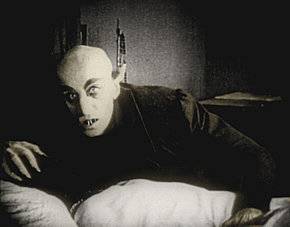
Nosferatu
(1922)
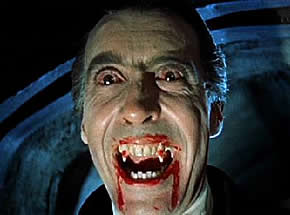
Horror
Of Dracula (1958)
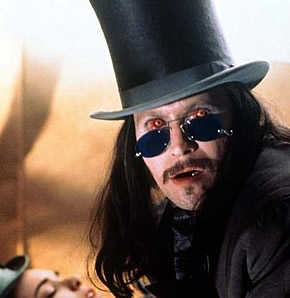
Dracula
(1992)

I
Am Legend (2007)
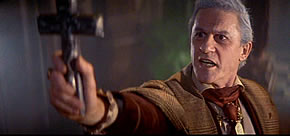
Fright
Night (1985)
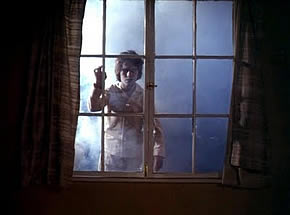
Salem's Lot (1979)
|







